Rowing: types, technology, competition. Olympic medalists in rowing
Rowing - cyclical sport that employs almost all muscle groups. Unlike canoeing or kayaking in the form of rowing athletes back moving forward. The most widespread was the sport in Western Europe, America, Australia, Russia, New Zealand and Romania. Since 1896 men's competitions in rowing are included in the Olympics program. Women have the opportunity to compete in rowing at the Olympic Games it appeared only in 1976. In addition, the annual rowing championship and the World Cup, as well as the Nations Cup. There is also a Cup and World Championship for youths and students. This is a brief description of rowing, now let's get to know her better!
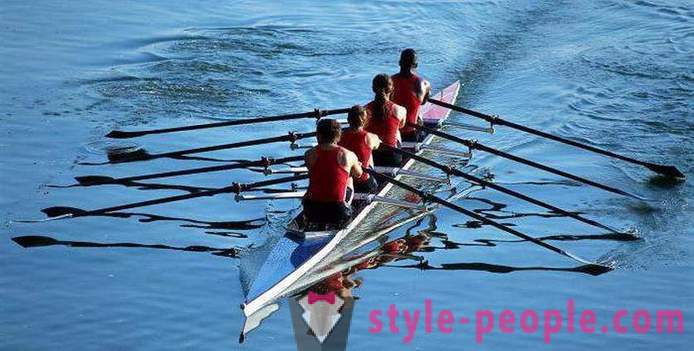
Basics rowing
There is no perfect rowing technique, as each athlete has their own technique and understanding of the process. From this it follows that the main task of rowing coach - adapting individual technique athlete to certain conditions. The main element of the process is directly rowing stroke. It consists of two stages: the beginning / hook / seizure and end. The purity of execution on both stages affects the speed of movement, balance, and the trajectory of the boat. Incidentally, depending on the direction of the stroke the boat can move both horizontally and vertically.
With the increase in the number of rowers in the boat influence the quality of the stroke on the course of the boat increases. Ideally, all athletes must both begin and end with the fungus. In fact, even the very best teams in the world rowers do not work simultaneously. Sometimes the difference reaches tenths and even hundredths of a second, but it is still there.
Types rowing
Rowing is a steam room and swing. In the first case, the athlete runs with two oars, each of which he holds in one hand. And in the second - rowing going on one oar, which is held with two hands. The boat crew may consist of one, two, four or eight rowers. In some classes regulated by the weight of the athlete. Compete in such disciplines as rowing, can men and women.
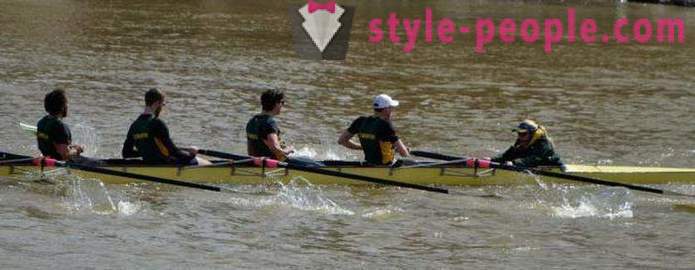
The Olympic program includes such classes of rowing:
- Single.
- Double Sculls's Pair and Double Sculls lightweight.
- The four swing and steam room.
- Eight.
This is the only Olympic rowing. Competition at the world championships are more diverse:
- Single light weight.
- Two of men with a steering oar, deuce men's lightweight swing.
- The four men with a steering oar, Quadruple Sculls lightweight.
- Eight men's lightweight.
In all classes, which was not specified floor athletes can compete in both men and women.
Steering weight is governed by rules. If the steering weighs less than normal, the boat loaded with ballast. Gender steering does not depend on gender of other crew members. Thus, the female steering carriage can be male and vice versa. The Olympic Games are no exception - here the whole team must be of the same sex. Commercial tournaments sometimes allowed to the crew were both women and men.

Classification rowers
In this sport there is a clear distinction between the rowers and a pair of oars swing. Athletes who work with hinged paddles are stroke and tanks. First hold the paddle on the left side, and the second - on the right. Calculations show that the stroke of the crew members for the smooth running of the boat should be put 5% more effort than tanks. The team with four or eight athletes are the strongest of them sit closer to the nose.
Features
Rowing is very much different from the rowing and canoeing. The differences relate to both the method of movement, and stress levels derived athlete. In the sport involved approximately 95% of human muscle groups. Here are the main differences from the rowing and canoeing:
- distance. It can range from 0, 5 to 160 kilometers. It all depends on the nature of the race. Junior "B" (16 years) floating at 0, 5-1 km. Junior "A" (16 to 18 years) - 1-2 km. Everyone else is considered standard 2-kilometer race. A distance of more than 2 kilometers are already in the marathon.
- The method of movement. A characteristic feature is the motion of rowing athletes back forward. To hold a predetermined path to help athletes buoys.
- movement speed. The average speed for the boat rowing is about 20 km / h. On jerks (start and finish), it increases to 30 km / h. This latter figure, which differs rowing. Eight, by the way, the fastest, both on the dash and in the middle distance.
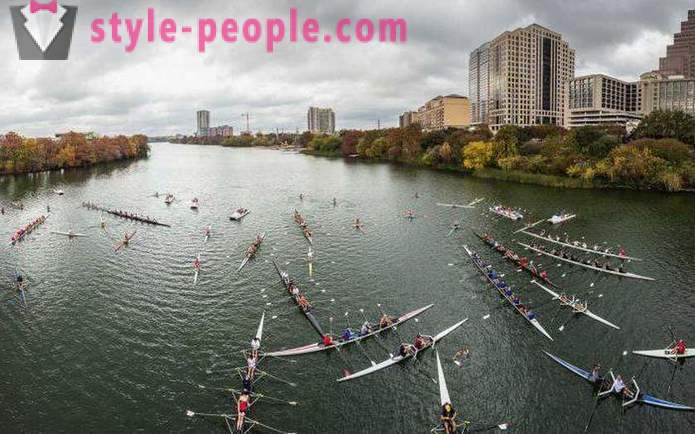
Boats
Boat for rowing is a light, narrow, elongated vessel, which has a movable seat swivels and handed over the side for attaching oars. Boats can be training and racing. In the first case, the vessel is slightly wider, and its side - higher. Initially the boats were made entirely of wood. Based on plating method, separation vessels appeared to "clinkers" and "skews". Boat "Clinker" is sheathed longitudinal rails, and "Skiff" - or plywood of valuable wood. Later replaced by plywood and veneer composite materials came. To date, "clinker" Cabin boats went into oblivion, so all the racing boats became known as simply "Scythians". Producing boats made of carbon materials on the principle of multi-layer "sandwich" began in 1980. The high-quality epoxy resins used in this technology as a link. Modern boats are quite expensive. The price of a single ship starts about a thousand dollars.
Paddles
Paddles used in rowing, are made on the basis of epoxy curing. They have high elastic-strength characteristics, operational stability and low weight. Vane paddle is made up of layers of eaves and is produced by the method of "direct" pressing. A rod which has an oval cross section made by winding followed by curing.
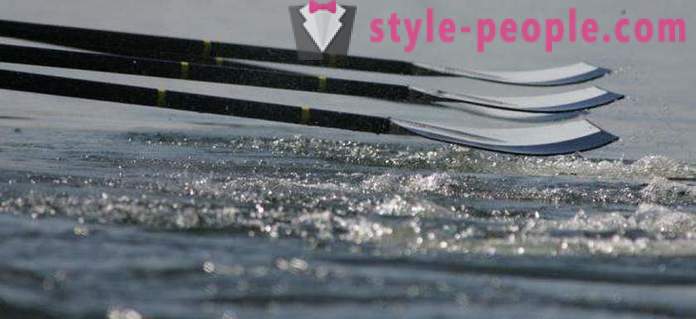
to inventory requirements
Official rules applied to such inventory requirements:
- To the competition are not allowed boats with fixed oarlocks.
- footrest should be done so that when you turn the boat it does not interfere with the rower in the shortest possible time to get out of the boat without using their hands.
- On the bow of the boat should stand holder for vane and white rubber ball.
- The minimum weight of the boat without oars and radio systems: single - 14 kg; Tie deuce - 32 kg; Double Sculls bezrulnaya - 27 kg; Four steering - 51 kg; Four bezrulnaya - 50 kg; chetvreka steam - 52 kg; Eight - 96 kg.
- The blades of the oars swing should be a minimum thickness of 5 millimeters. At the edges, the thickness decreases, starting from a distance of 3 mm from the edge. The blades are hinged paddles should have a thickness of 3 mm, starting at 2 mm from the edge.
Tradition
In the West Rowing has a long tradition, it is strictly and even with a certain passion supported athletes. The main ones are:
- Since the beginning of XIX in London on the River Thames runs classic Royal Regatta, in which competing crews of Oxford and Cambridge.
- The most common distance for a swim, if not to take into consideration children's and youth competitions - 2 km. The exceptions are a few classic British racing.
- stewards held before the starting signal boats. No technology is not used at the start.
- If a team has won in the swim, steering thrown into the water. If the steering is not in the team, all the crew members jump into the pool, holding hands.
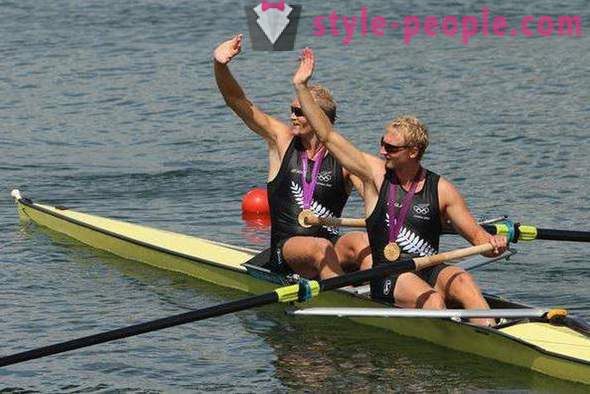
The terms
The specific terms and jargon can boast almost any sport. Rowing is not an exception. Consider some of them.
Bank. So called moving seat. It is made of wood or plastic, and goes on 4 wheels on special rails. Due to the mobility of the seat, an athlete can help kicking myself.
Footrest. Is a pair of shoes, fixed on a metal plate. It plays the role of support during the push. In the swim without a rudder, one of the rowing right shoe is connected to the steering mechanism, for adjusting the direction of movement.
Polozkov. This is the track on which the bank is moving.
Elbow / bracket. The metal tubes which are bonded together in the form of a cone and are mounted on the sides of the boat (in paired vessels - the left and right, swing - to the left or right). Play the role of a support for a paddle.
Bulwark. Plate fixed along the top side, perpendicular to it. It protects the crew from splashing.
Shade. Mounted behind the first issue and protects the crew from the water.
Swivel. is used for fastening the end of the paddle arm.
Spout. Rubber ball mounted on the bow of the boat. Prevents damage to equipment in a collision ship with anything.
Heel. Plastic part, which limits the length of the paddle.
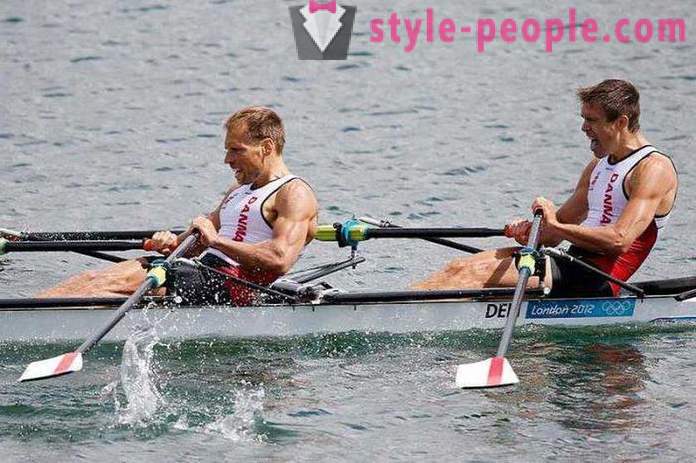
Outstanding rowers
Surprisingly, the youngest champion in rowing has become a 10-year-old boy, who was in the crew accidentally. He was taken into the team in place of the sick steering. This happened in 1990. The most outstanding rower Steve Redgrave was an Englishman. He won in all competitions, including the Olympics, for 20 years. Before the fifth Olympics in 1992, doctors found Steve diabetes. He did not give up and once again become a champion, and then retired from the sport. Repeat the achievement of Steve's dream of all Olympic champions in rowing. Incidentally, in the USSR, the figure was 18. In the Russian Olympic champions so far only four: Igor Kravtsov, spinal Nicholas Svirin Alexei and Sergei Fedorovtsev.
The International Federation of Rowing
The International Federation organizes and conducts competitions of different levels. In addition, she is working to expand the geography of the competition, the improvement of the rules, improving the methodology of training and other areas of development of the sport.













































